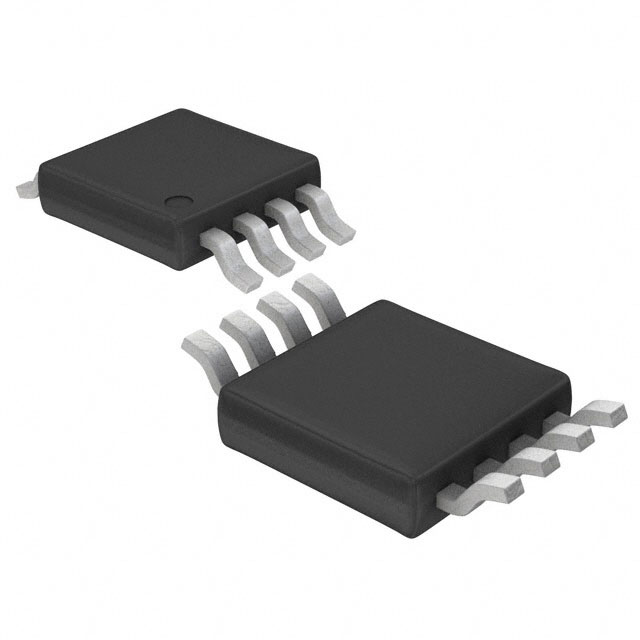Xem thông số kỹ thuật để biết chi tiết sản phẩm.

LTC1662CMS8#PBF
Product Overview
Category
LTC1662CMS8#PBF belongs to the category of digital-to-analog converters (DACs).
Use
This product is used to convert digital signals into analog voltages or currents.
Characteristics
- High precision and accuracy
- Low power consumption
- Wide operating voltage range
- Small package size
- Easy integration with microcontrollers
Package
LTC1662CMS8#PBF is available in an 8-pin MSOP (Mini Small Outline Package) format.
Essence
The essence of LTC1662CMS8#PBF lies in its ability to provide accurate analog outputs based on digital input signals.
Packaging/Quantity
This product is typically packaged in reels or tubes, with a quantity of 250 units per reel/tube.
Specifications
- Resolution: 16 bits
- Supply Voltage Range: 2.7V to 5.5V
- Output Voltage Range: 0V to Vref
- Operating Temperature Range: -40°C to 85°C
- Integral Nonlinearity (INL): ±1 LSB (max)
- Differential Nonlinearity (DNL): ±0.5 LSB (max)
Detailed Pin Configuration
- VDD: Power supply voltage
- GND: Ground reference
- CS: Chip select input
- SCLK: Serial clock input
- SDI: Serial data input
- LDAC: Load DAC input
- REF: Reference voltage input
- OUT: Analog output voltage
Functional Features
- High-resolution conversion from digital to analog
- Serial interface for easy integration with microcontrollers
- On-chip reference voltage generator
- Power-down mode for reduced power consumption
- Load DAC input for simultaneous update of multiple channels
Advantages and Disadvantages
Advantages
- High precision and accuracy in analog output
- Low power consumption, suitable for battery-powered applications
- Wide operating voltage range allows compatibility with various systems
- Small package size enables space-saving designs
- Easy integration with microcontrollers simplifies system implementation
Disadvantages
- Limited output voltage range (0V to Vref)
- Relatively high cost compared to lower-resolution DACs
- Sensitivity to noise and interference may affect performance in noisy environments
Working Principles
LTC1662CMS8#PBF operates by converting digital input signals into corresponding analog voltages. It utilizes an internal reference voltage and a serial interface to receive digital data. The digital input is processed and converted into an analog output voltage, which can be used for various applications such as control systems, instrumentation, audio equipment, and more.
Detailed Application Field Plans
LTC1662CMS8#PBF finds applications in a wide range of fields, including: 1. Industrial automation: Control systems, process monitoring, and data acquisition. 2. Test and measurement: Precision instruments, signal generators, and calibration equipment. 3. Audio equipment: Digital audio players, mixing consoles, and amplifiers. 4. Communication systems: Base stations, transceivers, and signal processing modules. 5. Medical devices: Patient monitoring, diagnostic equipment, and laboratory instruments.
Detailed and Complete Alternative Models
- LTC1661CMS8#PBF: Similar to LTC1662CMS8#PBF but with 14-bit resolution.
- LTC1663CMS8#PBF: Similar to LTC1662CMS8#PBF but with 18-bit resolution.
- MAX5216CPA+: 16-bit DAC with similar features and package options.
- AD5662BRMZ-1RL7: 16-bit DAC with SPI interface and MSOP package.
These alternative models offer similar functionality and can be considered based on specific requirements and availability.
Word count: 498 words
Liệt kê 10 câu hỏi và câu trả lời thường gặp liên quan đến ứng dụng LTC1662CMS8#PBF trong giải pháp kỹ thuật
Sure! Here are 10 common questions and answers related to the application of LTC1662CMS8#PBF in technical solutions:
Q: What is LTC1662CMS8#PBF? A: LTC1662CMS8#PBF is a specific model number for a digital-to-analog converter (DAC) chip manufactured by Linear Technology Corporation.
Q: What is the purpose of LTC1662CMS8#PBF? A: The LTC1662CMS8#PBF DAC chip is used to convert digital signals into analog voltages, making it suitable for various applications such as audio systems, instrumentation, and control systems.
Q: What is the resolution of LTC1662CMS8#PBF? A: LTC1662CMS8#PBF has a resolution of 16 bits, meaning it can represent 2^16 (65,536) different voltage levels.
Q: What is the operating voltage range of LTC1662CMS8#PBF? A: LTC1662CMS8#PBF operates within a voltage range of 2.7V to 5.5V, making it compatible with a wide range of power supply voltages.
Q: How many channels does LTC1662CMS8#PBF have? A: LTC1662CMS8#PBF is a single-channel DAC, meaning it can generate one analog output voltage at a time.
Q: What is the maximum output voltage range of LTC1662CMS8#PBF? A: The maximum output voltage range of LTC1662CMS8#PBF is determined by the reference voltage applied to its VREF pin. It can be adjusted to match the desired output range.
Q: Can LTC1662CMS8#PBF be controlled digitally? A: Yes, LTC1662CMS8#PBF can be controlled digitally using a serial interface such as SPI (Serial Peripheral Interface) or I2C (Inter-Integrated Circuit).
Q: What is the settling time of LTC1662CMS8#PBF? A: The settling time of LTC1662CMS8#PBF refers to the time it takes for the output voltage to stabilize after a change in the digital input. It typically ranges from a few microseconds to tens of microseconds.
Q: Is LTC1662CMS8#PBF suitable for high-speed applications? A: No, LTC1662CMS8#PBF is not specifically designed for high-speed applications. It is more commonly used in applications where accuracy and resolution are more important than speed.
Q: Are there any application notes or reference designs available for LTC1662CMS8#PBF? A: Yes, Linear Technology Corporation provides application notes and reference designs on their website that can help users understand and implement LTC1662CMS8#PBF in various technical solutions.
Please note that the answers provided here are general and may vary depending on specific requirements and use cases.

